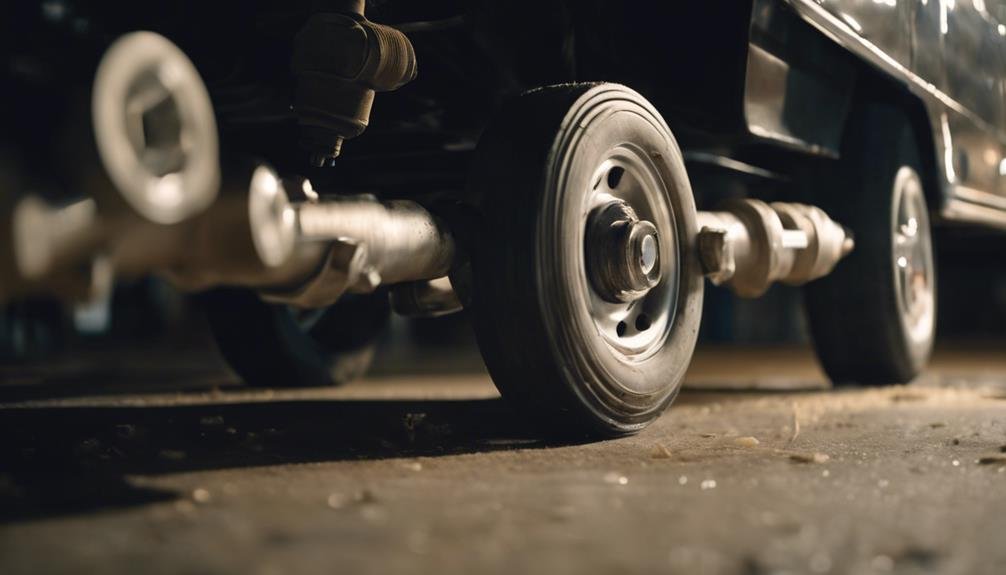As you rely on your vehicle to transport you safely and efficiently, an axle plays a vital role in transferring power from the engine to the wheels, supporting the vehicle's weight, and contributing to steering control, making it an essential component that deserves your attention. An axle's role can vary, depending on whether it's a front-wheel-drive, rear-wheel-drive, or all-wheel-drive vehicle. From transferring power to supporting your vehicle's weight, the axle's functionality is multifaceted, and its importance cannot be overstated. Now that you've started exploring the world of axles, you're just a step away from uncovering more about the intricacies of this critical vehicle component.
Key Takeaways
- An axle is a critical vehicle component that transfers power from the engine to the wheels, supporting the vehicle's weight and contributing to steering control.
- The type of axle used (front-wheel-drive, rear-wheel-drive, etc.) affects the vehicle's performance, handling, and functionality.
- Axles consist of various components, including drive axles, axle housings, driveshafts, and CV joints, which work together to transmit power and support the vehicle's weight.
- Regular inspection and maintenance of axles are crucial to prevent common issues like worn CV joints, damaged axle boots, and axle seal leaks, which can lead to costly repairs.
- The selection of the right axle ratio is vital, as it affects the vehicle's performance, towing capacity, and fuel efficiency, and depends on factors like torque, motor, and transmission specifications.
Understanding Axle Functionality
As you rely on your vehicle to get you where you need to go, your axle plays a vital role in transferring power from the engine to the wheels, supporting the vehicle's weight, and contributing to steering control. Essentially, the axle is a key component that enables your car to drive smoothly and efficiently.
In a front-wheel-drive vehicle, the front axle is responsible for transmitting power to the front wheels, while in a rear-wheel-drive car, the rear axle takes on this task. In all-wheel-drive vehicles, the axle distributes power to all four wheels, providing improved traction and control.
The transmission and axle work in tandem to make sure that power is delivered seamlessly to the wheels, allowing you to accelerate, brake, and steer with confidence. By understanding the axle's functionality, you'll appreciate the intricate mechanisms that keep your vehicle running smoothly, and be better equipped to identify potential issues before they become major problems.
Types of Axles Explained
You'll find four primary types of axles in vehicles, each serving distinct purposes that impact your driving experience.
Front axles, for instance, support steering and absorb shocks, contributing to the vehicle's stability and handling. They're connected to the front wheels via stub axles, which play a key role in the rotation and movement of the wheels.
Rear axles, on the other hand, transmit power to the driving wheels, vital for propulsion and movement. Most rear axles are live axles, actively transmitting power between the differential and the drive wheels.
In contrast, dead axles, found on both front and rear ends, provide structural support and aid in wheel alignment. These types of axles are fundamental components of car axles, working together to ensure a smooth and safe ride.
Understanding the different types of axles and their functions is important for appreciating the complexity of modern vehicles. By recognizing the roles of front axles, rear axles, stub axles, dead axles, and live axles, you'll gain a deeper appreciation for the intricate mechanics that power your vehicle.
Axle Components and Design

With a vehicle's axle system comprising multiple components, each plays a vital role in ensuring a smooth and safe ride. You'll find drive axles, axle housings, driveshafts, dead axles, front axles, and rear axles, all working together seamlessly.
The drive axles transfer power to the wheels, while axle housings support the vehicle's weight, and driveshafts deliver torque from the transmission to the final drive. Dead axles, like the dead front axle, support vehicle weight and aid in wheel alignment.
Front axles, on the other hand, assist with steering, absorb shocks, and connect the front wheels to the front axle via stub axles. Rear axles, typically live axles, transmit power between the differential and drive wheels, ensuring power is delivered efficiently to the rear wheels.
The CV axle, featuring a CV joint, enables smooth power transmission while allowing for suspension movement. Regular inspection of these components, particularly U-joints or CV joints, is essential for optimal performance and safe driving conditions.
Common Axle Issues and Repairs
Since all axle components collaborate to guarantee a smooth ride, it's no surprise that even a single faulty part can cause a ripple effect, leading to common axle issues that require prompt repairs.
As you drive, your axles are working together to transmit power from the transmission to the wheels, but if one part fails, the entire system can be compromised.
Common issues include worn CV joints, damaged axle boots, and axle seal leaks, which can cause vibrations, clicking noises, and even grease splatter. If you notice any of these signs, it's important to address the problem quickly to avoid more costly repairs down the line.
CV axle replacement costs can range from $300 to $1,500, including parts and labor. Regular inspection of U-joints or CV joints is vital for axle maintenance, and DIY guides are available for specific models.
Axle Maintenance and Inspection

Proper axle maintenance begins with regular inspections, which can be as simple as listening for unusual noises during turns or checking for leaks around axle boots. By doing so, you can detect axle issues early on and prevent costly repairs down the line.
Regular axle maintenance is vital for safe driving, as it guarantees your vehicle is in good working condition. When you neglect axle maintenance, you risk experiencing signs of axle problems, such as vibrations while driving, loud clicking noises, and uneven tire wear. These issues can lead to a rough ride and, if left unchecked, can cause more severe problems.
Importance of Axle Ratio Selection
When you're customizing your vehicle or upgrading your axle, selecting the right axle ratio becomes essential, as it directly affects your vehicle's performance, towing capacity, and fuel efficiency. The axle ratio determines how many turns the drive shaft makes per wheel turn, which in turn impacts your vehicle's performance as a whole.
Choosing the appropriate axle ratio is vital for the best towing capacity and fuel efficiency. For example, higher axle ratios are ideal for heavy towing, while lower ratios can improve gas mileage. However, the most suitable axle ratio for your pickup truck depends on unique torque, motor, and transmission specifications.
Taking these factors into account, you can optimize your vehicle's performance by selecting the right axle ratio. A well-suited axle ratio ensures that your vehicle can handle heavy loads efficiently, while also providing excellent fuel efficiency.
Axle Failure Symptoms and Diagnosis

You'll likely notice axle failure symptoms while driving, such as loud clicking or clunking noises during turns, which can be a sign of a more serious problem that demands immediate attention. These noises often indicate worn-out or damaged axle components, which can lead to more costly repairs if ignored.
Another sign of axle issues is grease on the edge of the tire or underneath the vehicle, indicating a leak in the axle seals or bearings. Vibrations or shaking while driving are common signs of axle problems, which can also cause uneven tire wear.
If your vehicle pulls to one side, it could be a sign of axle issues that require attention. To diagnose axle problems, it's crucial to look for these symptoms and address them promptly. A thorough inspection and diagnosis by a qualified mechanic can help identify the root cause of the issue and recommend the necessary repairs.
Choosing the Right Axle for Your Vehicle
Now that you've identified signs of axle failure and diagnosed the issue, it's time to contemplate replacing or upgrading your axle. Selecting the right one for your vehicle is key to optimizing its performance, fuel efficiency, and towing capacity.
When choosing an axle, consider factors like load-carrying capacity, suspension system, and drive type. The size and weight of your vehicle play a vital role in determining the appropriate axle, as it directly affects the overall performance and efficiency of your ride.
Also, cost factors, including purchase price, maintenance, and fuel costs, should be considered when making your decision. It's crucial to consult your vehicle manual or technical specifications to get valuable information on selecting the right axle for your specific vehicle.
Frequently Asked Questions
Why Are Axles Important?
You depend on axles to transfer power, support your vehicle's weight, and guarantee smooth driving. Without them, you'd be stuck with a car that can't move, making axles a vital component of your vehicle's comprehensive performance.
Can You Drive With a Broken Axle?
You shouldn't drive with a broken axle – it's extremely dangerous and can cause loss of control, accidents, and further damage to your vehicle, putting you and others at risk, so have it towed to a repair shop immediately.
How Can I Tell if My Axle Is Bad?
You can determine if your axle is bad by paying attention to unusual sounds, vibrations, or grease leaks while driving, and inspecting for signs of wear, damage, or uneven tire wear patterns on your vehicle.
What Is Axle in Simple Words?
You're wondering what an axle is in simple words? Think of it as a rod that connects your wheels, allowing them to turn and receive power from the engine, making your vehicle move.
Conclusion
Now that you've explored the world of axles, you've gained a deeper understanding of their functionality, types, components, and importance.
You're equipped to identify common issues, perform routine maintenance, and select the right axle for your vehicle.
Remember, a well-maintained axle is essential for best performance, safety, and fuel efficiency.
By prioritizing axle health, you'll enjoy a smoother ride, reduced repair costs, and a longer vehicle lifespan.
